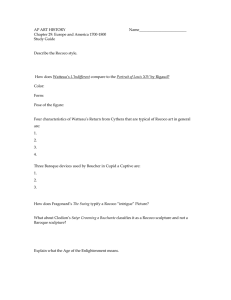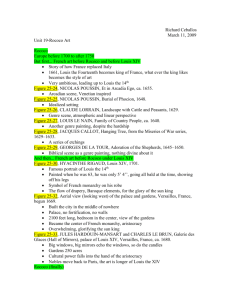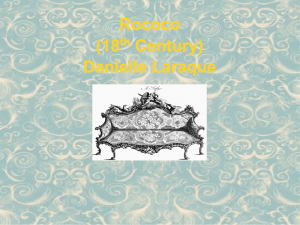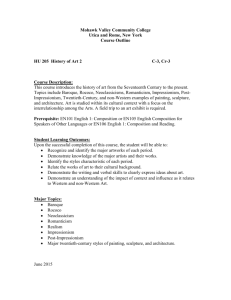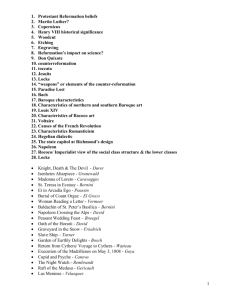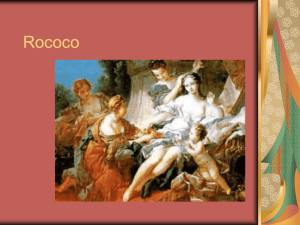Rococo_Presentation
advertisement
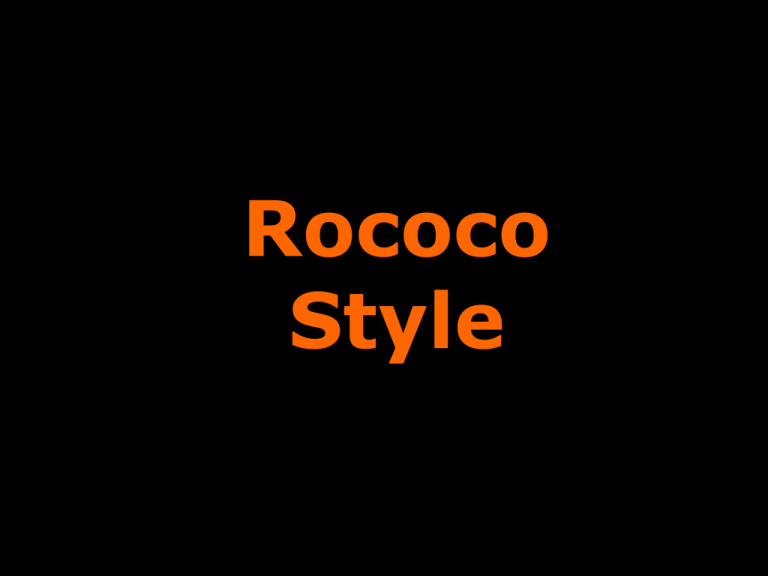
Rococo Style Chronology The Eighteenth Century • • 1709 • Discovery of the ruins of Herculaneum 1714-1820 • Georgian period in England 1715 • Death of Louis XIV, his great-grandson, becomes king 1733 • John Kay patents the flying shuttle c. 1720-c. 1770 • Rococo styles in the arts predominate c. 1770-mid-1800 • Neoclassical styles in the arts predominate 1740-1786 • Frederick the Great rules in Prussia, builds rococo and neoclassical palaces 1745 Madame Pompadour becomes mistress of King Louis XV and influences arts and fashions of the French court 1748 Discovery of the ruins of Pompeii, which along with excavations at Herculaneum, helps to stimulate neoclassical revival Chronology The Eighteenth Century Continued 1756 • Birth of Mozart 1764 • James Hargreaves invents spinning jenny 1769 • Richard Arkwright develops the spinning machine 1774 • Death of Louis XV • Louis XVI, his grandson, becomes king 1776 • American Revolution 1789 • French Revolution 1791 • Death of Mozart 1796 • James Watt invents the steam engine 1789 • Convening of the Estates General in France • Storming of the Bastille • Declaration of the Rights of Man 1792 • Abolition of the French monarchy The Eighteenth Century Selected European Rulers England France Stuarts 1603–1714 Bourbons 1589–1792 Anne 1702–14 Louis XIV, le Roi Soleil 1643–1715 Louis XV, le Bien–Aimé 1715–74 Louis XVI 1774–92 Hanoverians 1714–1901 George I 1714–27 George II 1727–60 George III 1760–1820 Holy Roman Empire Joseph I 1705–11 Charles VI 1711–40 Maria Theresa 1740–80 Joseph II 1765–90 Leopold II 1790–92 Franz II (Francis II) 1792–1806 Spain Bourbons 1700–1808 Felipe V (Philip V) 1700–1724 (abdicated) Luis I (Louis I) 1724 Felipe V (Philip V) 1724–46 (reinstated) Fernando VI (Ferdinand VI) 1746–59 Carlos III (Charles III) 1759–88 Carlos IV (Charles IV) 1788–1808 Prussia Hohenzollerns 1701–1797 Friedrich I 1701–13 Friedrich Wilhelm I 1713–40 Friedrich II, der Grosse, (the Great) 1740–86 Friedrich Wilhelm II (Frederick William II) 1786–97 Characteristics of the Rococo Style: The fanciful and often playful furniture and architectural decoration grew out of the Baroque and became fashionable in France in the 1720s. In architecture the style is mostly limited to the exterior façade ornamentation. The term is derived from the combination of Baroque and French Ideals. Rocaille [roh-kahy ]: a rock/shell ornamentation used in garden architecture. The French court move from Versailles to Paris to escape the formality and restrictions that had dominated Louis XIV's court life. Salons (gatherings), largely hosted by educated women of the upper class, were called salons. Characteristics of the Rococo include: • a light, fanciful, feminine approach to decoration • the preoccupation of society with a romantic view of life, and a tendency towards eroticism and superficiality • a reaction to the rigid "grand manner" of court life under Louis XIV < Louis XV was king of France from 1715 to 1774. He was nicknamed 'the Well-Beloved', but his failures contributed to the crisis that brought on the French Revolution. Louis was born at Versailles and at the age of five, he succeeded his great grandfather Louis XIV as king of France. Rococo Architecture Church of Il Gesù (Rome, 1584) Hospicio de San Fernando (Madrid, 1722) Shift from the classical to the expressionistic Ornate, fanciful and often playful artwork and architectural decoration Round arches, cornices, pilasters - and the classical principle of symmetry Overlaid with swags, finials, shell and plant forms as to appear to melt The contrast between the two façades illustrates the shift from the classical to the expressionistic - between the beginning of the Baroque and the end of the Rococo. In the period between the death of Louis XIV (1715) and the American Revolution (1775), a decline in the powers of Church and State was evident all over monarchical Europe. The Rococo style can be defined as a dénouement of the Baroque, and is best seen in the curvilinear, feminine imagery of this interior decoration. Typical elements in Rococo decoration: : • asymmetry • natural plant forms such as the acanthus (perennial herb) scroll • the arabesque, S shapes, C shapes, and reverse C shapes • silver or gold gilt highlights against white or pastel backgrounds • mirrors to break up the surface and reflect the gilt and the glitter of crystal chandeliers. • carved wood panels and inlaid wood designs on furniture (marquetry) and floors (parquetry) The Mirror Room – Amalienburg Palace (Munich 1734) A pavilion for Royal relaxation by François de Cuvilliers who almost single-handedly responsible for the spread of the Rococo style to Bavaria and then to the rest of Germany and Austria Boiserie [bwah-zuh-ree]: Interior Sculptured Wall Paneling … (usually floor to ceiling)… as a rule enriched by carving, gilding, and painting (rarely inlayed) Furniture and Decoration French Rococo shows its anti-classical nature in several ways: • a rejection of the use of the classical Orders in supports and structural elements, • an embrace of asymmetry, • restless and flickering movement. • the use of asymmetrical scrolls, scallop shells, elongated S and C curves, After 72 years of the Louis XIV reign, there arose in Paris new types of private patrons -- nobles created by the sale of offices, nouveau riche tax collectors, and millionaires and bankers fat on the spoils of financing 25 years of disastrous wars. They luxuriated in a new artistic freedom, indulged their highly individualistic tastes, and welcomed fresh ideas in decoration. Hôtel de Varengeville (Paris 1735) Nicolas Pineau Carver and Ornamental Designer French Rococo painting in general was characterized by easygoing, light-hearted treatments of mythological and courtship themes, rich and delicate brushwork, a relatively light tonal key, and sensuous coloring. Jean-Honoré Fragonard “The Swing” (1767) This is a scene of wish-fullfilment - a warm dusk in the marble-vaulted summer-house of an Italian garden. There is music from a rustic band, dancing in fancy-dress, romance, flirtation and chat. Watteau provides a glimpse of Earthly Paradise for the urbane. To the eighteenth -century viewer this scene would have appeared far more informal than it does to us. This scene would have conveyed the idea of liberty. Antoine Watteau “Les Plaisirs du Bal” (Pleasures of the Ball) (c. 1719) Louis XIV Louis XV Louis XVI The chair was now designed for the human body, in contrast to the sculptural approach to furniture in the Classical Baroque. Cabriole Legs: tapering legs curving outward at the top and inward farther down so as to end in a round pad, the semblance of an animal's paw) <German Rococo (1765) Console Table (usually topped with a mirror) ^French Rococo Commode (storage cabinet) Note the Serpentine curves which illustrate decoration as organic growth ^Rococo Furniture replicating behavior patterns • Tête-a-tête (or confidante): seating two people • Canapé a confidante (closed at both ends with a corner seat. ) • Four-seater The Tapestry Room (London 1776) In the last third of the 18th Century, a new wave of neo-classicism modified some of the extremes of the Rococo. Designers turned towards a more masculine, heavier approach, with more symmetry in ornament and form. The style has been referred to as Louis XVI, after that doomed monarch whose own personal restraint had little effect on the events to come. The Georgian Era - England: King George I The Baroque was condemned as being over-emotional and undisciplined The domestic interior became a place of calm and cool primness. Cabriole legs Thomas Chippendale… open and less upholstered, with natural wood finishes instead of gilt. Rococo Dress The delicate frothiness of the Rococo was reflected in clothing styles. From the 1720s until the Revolution, French taste dominated Europe. The Rococo style spread to England, Spain, central Europe, and even into Russia. This period of aristocratic negligence and nostalgia drifted to a final conclusion in the bloodshed and turmoil of the French Revolution. During the Revolutionary period, 1787 - 1795, the last vestiges of aristocratic dress were swept away, along with the individuals who wore them. The painting below captures the graceful indolence of the lifestyle. The Declaration of Love By Jean-Francois De Troy (1731) Innovation in Dress Textile manufacturing, mostly of cotton, advanced rapidly during the century. Increasing trade with the Orient brought new garment types and textiles. Imported Oriental silk brocades and Indian chintz, calico and muslin (all cotton of different weaves and finishes) were copied by European manufacturers. The 18th century saw the explosion of the slave trade, as American cotton production grew to satisfy demand. Dress was divided into three categories corresponding to social demands: • Undress: lounging clothes • Dress: daytime outfits • Full Dress: formal or court appearances. The Men The Declaration of Love By Jean-Francois De Troy (France, 1731) 1715-1790, Men's costume retained the artificial Elizabethan silhouette - padded doublet and breeches and the starched ruff for the first two decades of the century. Shirts features a narrow band of linen tied at the neck, the cravat. The waistcoat extended to the knee, and was of rich brocades: fabric woven with an elaborate design. This painting shows the typical silhouette of the first three decades of the century. Wigs, much reduced in size from the end of the 17th century, were tied back into a queue with a black ribbon, and powdered. Shoes had low heels and large silver buckles. The Men Sir George Lucy By Pompeo Batoni (England, 1758) Full dress called for coats and waistcoats in embroidered satins or velvets paired with plain breeches. In the second half of the century, the turnedback cuff disappeared and the front edges of the coat front no longer met across the chest, exposing more of the fabric of the waistcoat. Wigs were more formally dressed, with tight sausage rolls running in rows around the head, and a queue tied into a black velvet bag. The wearing of the wig for men persisted into the mid-century. The Men Embroidered Court Coat (England, 1770’s) Court costume maintained its formality and embellishment until the Revolution. This detail from a court coat of the 1770s reflects the interest in surface decoration of the Rococo style. (NO LACE – ALL embroidered) The Men Portrait Of William Colyear Viscount Milsington By Allan Ramsay (England, 1764) Ditto Suit, was firmly established for dress, that is, day wear… same as the ensuite (or suit of clothes) which included coat, waistcoat and breeches all cut from the same fabric. Bag-Wig: powdered with the queue (tail) of the wig enclosed in a black bag. The Men Robert Baddeley as Moses in School for Scandal By Johann Zoffany (c. 1781) Black felt cocked hat - which acquired the term tricorne in the 19th century. The Women The Declaration of Love By Jean-Francois De Troy (France, 1731) 1715-1790, Since the Elizabethan period, women's dress had involved some form of corset and skirt support. Several forms of understructure played an important part in the female silhouette from 1720 to 1775. Female costume reflected the casual and relaxed mood of the beginning of the century. As the century progressed, costume pieces proliferated, and a multitude of accessories were purchased at the whim of the latest fad Sack (sacque) gown: loosely fitted with pleats at the back that fell from the shoulder to floor, was worn over a dome-shaped hoop. The Women Madame De Pompadour By Francois Boucher (France, 1759) After 1730, the sack (sacque) gown was seen in a new form, retaining the loose back pleats and train, but fitted to the torso in the front. Open Bodice Stomacher decorated with eschelles: a graduated row of ribbons/bows Skirt split in front to reveal petticoat Neckline low to reveal chemise Collarette: Ruff or choker-like necklace Engageants: two or three ruffles that finished sleeves that ended below the elbow The Women Robe a la Française (Watteau Gown ) (France, 1765) Court dress retained some of its earlier formality in the richness of the fabrics and embellishment. Pannier: basket hoop Corsets, hoops and pannier structures were to persist to the last decade of the century. The Women Polonaise Dress (France, 1770’s) In the 1760s, the overgown was drawn up with rings and tapes into puffed loops, a sort of "roman shade", that exposed the petticoat. Rows of ruffles proliferated on skirt bottoms and edges. The wig was adopted by women and dressed in curls to a sometimes fantastic height. Women (with the help of some really creative hair dressers) supplemented their own hair with pads (rats) and false hair building the hair up and creating gravity defying up sweeps. The look was a nostalgic throwback to an idealized concept of the styles of country folk. It reflected the new spirit of democracy and the ideas of the philosopher Jean Jacques Rousseau, who advocated a return to the simple life. The Women Portrait of Antoine-Laurent Lavoisier and Marie-Anne Lavoisier By Jacques-Louis David (France, 1788) 1780-1800, the new spirit of reform began to influence every day clothing, and a transformation occurred in women's dress that was to completely sweep away the ornamental fussiness of lace, ruffles and hoops. Chemise dress: a one-piece, white cotton muslin gown, was devoid of all decoration, and resembled nothing so much as a chemise undergarment. Another new 'natural' style is the chemise a la reine (Queen's chemise). This fashion surfaces around 1781, after MarieAntoinette was spotted wearing a gown in the style of her chemise in her garden. Hedgehog Hair also ‘natural’ and architectural. The Women Late Georgian-Women (1760-1795) Anglomania: France interest in the English "country" style Late 18th Century women's clothing is greatly influenced by the passing of leisure time "in the country." Women start to appreciate looks that are, in their eyes, more "natural." While clothing styles are "simplifying," hair styles continue to expand, reaching their largest altitudes (12-18" tall) during the 1770s. "Country" influences include: -Shortened skirts (shy of the ankle) -Skirts of gowns looped, draped, and pulled to the back -Narrower panniers and/or sole reliance on the false rump as an understructure. -Mob cap variations worn as headdress outside the boudoir. -Wide brimmed, low crowned bergere/shepardess hats. -More frequent use of bodice & skirt and gown & non-matching petticoat ensembles (like the girl in brown at the right). Discussion Discuss these 2 images in regard to the ELEMENTS OF DESIGN ^Salle des Gardes at Versailles (1670s) >Hôtel de Soubise In Paris (1740s)
